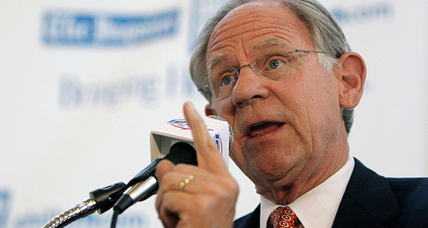Campaign finance reformers often conflate persuasion and coercion. In Randall v. Sorrell they sought to recast the government’s “corruption” interest, the standard justifying all campaign finance regulation, from preventing legislative quid pro quo to preventing an inequality of campaign resources; governmental management of an “arms race” because it forces voices and persons out of the process. They believe that Jon Corzine once won a Senate seat because he spent $65 million dollars; that voters are powerless against it. Reformers tend to forget that Corzine didn’t win by much, and certainly not in proportion to his spending, and forget Michael Huffington who spent $21 million in a losing campaign. Perhaps advertising is not coercion, and there is some intermediary step taken between campaign spending and citizen voting.
It is too bad that Jared DeMarinis, director of the Maryland State Board of Elections, doesn’t see that there is a step between soliciting contributions and seeking votes. If so, he might not have referred Governor Bob Ehrlich to a State prosecutor. What is Ehrlich’s supposed crime? He employed the tried and true “dollar bill mailer” to raise campaign contributions, a staple used for years in the direct mail business. Ehrlich’s letter, true to form, says that he has “taken the extraordinary step of sending … a real dollar bill” in hopes contributors would support him with $25. In Maryland it is illegal to give people money to garner their vote, but that’s not what Ehrlich was doing. Maryland also requires campaign expenditures to be made by check, but I can assure you that Ehrlich’s campaign wrote a check — to a direct mail vendor who employs the dollar-bill-mailer as a fundraising technique. Campaign staffers were not stapling bills from the petty cash account.
Ehrlich’s campaign rightly called the complaint “ridiculous.” But what is the subheading in the Washington Post? “Ehrlich Mailing May Have Violated Law, Elections Board Says.” John Wagner, “Prosecutor to Review Dollar-Bill Tactic,” Washington Post, October 7, 2006, B4. We are told that “potential violations … carry the possibility of fines and prison time.” Id. Again we see campaign finance law becoming the instrumentality for deciding elections; a cudgel to be employed by campaign competitors, and a ticket to relevancy for election commissions everywhere. Most candidates would be eager to capitalize on a bureaucrat’s wading into his election against his opponent mid-October, but thankfully Ehrlich’s opponent is taking the high road. Says Rick Abruzzese, spokesman for Democratic challenger Martin O’Malley: “We’re not going to comment on the fact that Bob Ehrlich’s floundering campaign is now under criminal investigation.”
This reform madness has been brought to us by a sustained campaign of persuasion. But it is and remains a campaign for coercion. Such is the nature of legal remedy.
Ehrlich’s persuasive technique is known in the trade as “reciprocation.” “The rule says we should try to repay, in kind, what another person has provided us.” Robert Cialdini, Influence: The Psychology of Persuasion p. 17 (rev ed. 1993). Why should Ehrlich’s method be any less legal than others? Indeed, the reformers have themselves employed a new persuasive technique known as “commitment and consistency.” Three “reform” organizations are rolling out their Voters First Pledge. The pledge is simple. It asks candidates to sign onto a number of measures all designed to “make elections fair; restore accountability; and protect voters’ right to know.” Who could be against it? But the devil is in the details, and we shouldn’t expect reformers to let candidates’ commitments stop there. As Robert Cialdini writes in Influence: the Psychology of Persuasion, p. 67 (rev. ed. 1993) “[e]ach of the [commitment] strategies is intended to get us to take some action or make some statement that will trap us into later compliance through consistency pressures.”
During the Korean War, Cialdini explains, captured American soldiers found themselves in Chinese prisoner of war camps and subjected to techniques of commitment and consistency.
[T]he first problem facing the Chinese was how to get any collaboration at all from the Americans. These were men who were trained to provide nothing but name, rank and serial number.
Prisoners were frequently asked to make statements so mildly anti-American as to seem inconsequential. But once these minor requests were complied with, the men found themselves pushed to submit to related yet more substantive requests. [A man might later be asked to commit his statement to writing] and sign it.
The Chinese might then use his name and [statement] in an anti-American radio broadcast. Suddenly he would find himself a “collaborator,” having given aid to the enemy. Aware that he had written the essay … many times a man would change his image of himself to be consistent with the deed and with the new “collaborator” label, often resulting in even more extensive acts of collaboration.
Id. at 71.
The reformers are hoping to convince candidates to “change their image of themselves” from advocates of speech, petition and association to advocates of “fairness,” “accountability,” and the “right to know” — details to be determined later. Some may wince at the spectacle of reformers employing such tactics and believe, as DeMarinis believed in relation to Ehrlich, that something must be done. But conservative mail guru Benjamin Hart remembers, even as reformers forget, that no matter how slick an advertising campaign, people retain freewill. In his book, Fund Your Cause with Direct Mail (2005), Hart says, at pp. 139-40, that “[e]nclosing a $1 bill with a letter is a great way to get a reader’s attention. [B]ut the need better be truly urgent, or your $1 bill mailing will crash and burn.”














